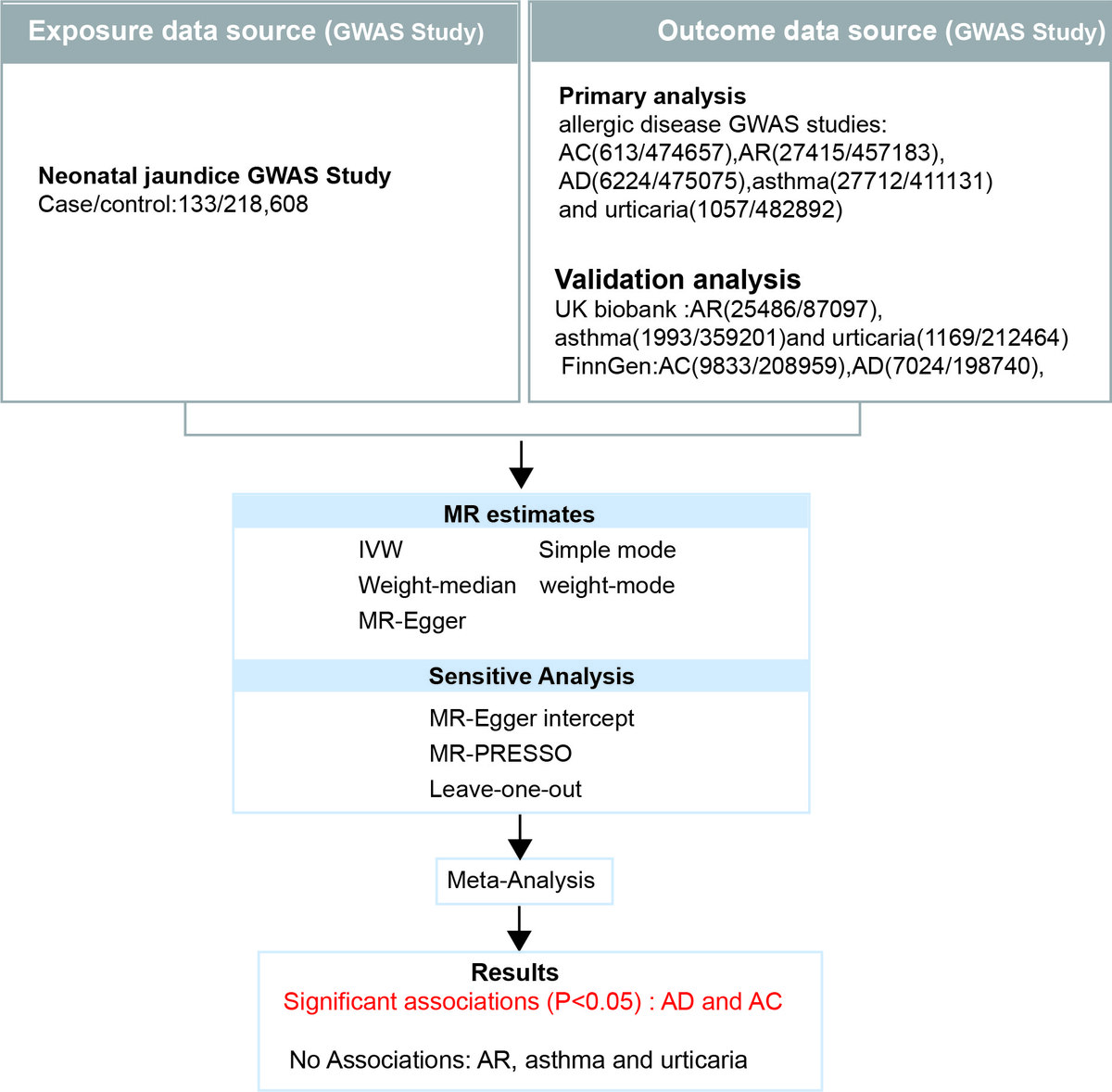Current issue
Archive
Manuscripts accepted
About the Journal
Editorial office
Editorial board
Section Editors
Abstracting and indexing
Subscription
Contact
Ethical standards and procedures
Most read articles
Instructions for authors
Article Processing Charge (APC)
Regulations of paying article processing charge (APC)
NEONATOLOGY / RESEARCH PAPER
Unraveling the Impact of Neonatal Jaundice on Allergic Diseases: A Mendelian Randomization Study
1
Department of Pediatrics, The First Affiliated Hospital, Jiangxi Medical College, Nanchang University, China
Submission date: 2024-08-17
Final revision date: 2025-02-02
Acceptance date: 2025-02-17
Online publication date: 2025-04-27
Corresponding author
gaole yuan
Department of Pediatrics, The First Affiliated Hospital, Jiangxi Medical College, Nanchang University, nanchang, China
Department of Pediatrics, The First Affiliated Hospital, Jiangxi Medical College, Nanchang University, nanchang, China
KEYWORDS
TOPICS
ABSTRACT
Introduction:
Neonatal jaundice, a condition characterized by elevated bilirubin levels in newborns, is prevalent, affecting up to 60% of term infants. Previous observational studies have linked neonatal jaundice to an enhanced risk of allergic diseases such as asthma, atopic dermatitis (AD), allergic conjunctivitis (AC), allergic rhinitis (AR), and urticaria. However, the causal relationship remains unclear due to potential confounding factors and reverse causality.
Material and methods:
We conducted a two-sample MR analysis using genetic variants as instrumental variables. Data from large-scale GWAS in European populations were utilized, including exposure data for neonatal jaundice and outcome data for the five common allergic diseases. MR analysis was performed using the Inverse Variance Weighted (IVW) method, with additional sensitivity analyses conducted using MR-Egger regression, weighted median, simple mode, and weighted mode methods.
Results:
MR analysis revealed a significant causal association between neonatal jaundice and an increased risk of AD (OR = 1.0141, 95% CI 1.0041-1.0241, P = 0.006) and AC (OR = 1.0119, 95% CI 1.0014-1.0226, P = 0.026). No significant association was found between neonatal jaundice and pediatric asthma, urticaria, or AR. Sensitivity analyses indicated no evidence of pleiotropy, and no individual SNPs exerted substantial influence on the robustness of the results, confirming the robustness of our findings.
Conclusions:
This study provides evidence for a causal association between neonatal jaundice and an increased risk of AD and AC. These findings suggest that neonatal jaundice may be a modifiable risk factor for AD and AC, highlighting the importance of neonatal jaundice management and further research on potential preventive strategies.
Neonatal jaundice, a condition characterized by elevated bilirubin levels in newborns, is prevalent, affecting up to 60% of term infants. Previous observational studies have linked neonatal jaundice to an enhanced risk of allergic diseases such as asthma, atopic dermatitis (AD), allergic conjunctivitis (AC), allergic rhinitis (AR), and urticaria. However, the causal relationship remains unclear due to potential confounding factors and reverse causality.
Material and methods:
We conducted a two-sample MR analysis using genetic variants as instrumental variables. Data from large-scale GWAS in European populations were utilized, including exposure data for neonatal jaundice and outcome data for the five common allergic diseases. MR analysis was performed using the Inverse Variance Weighted (IVW) method, with additional sensitivity analyses conducted using MR-Egger regression, weighted median, simple mode, and weighted mode methods.
Results:
MR analysis revealed a significant causal association between neonatal jaundice and an increased risk of AD (OR = 1.0141, 95% CI 1.0041-1.0241, P = 0.006) and AC (OR = 1.0119, 95% CI 1.0014-1.0226, P = 0.026). No significant association was found between neonatal jaundice and pediatric asthma, urticaria, or AR. Sensitivity analyses indicated no evidence of pleiotropy, and no individual SNPs exerted substantial influence on the robustness of the results, confirming the robustness of our findings.
Conclusions:
This study provides evidence for a causal association between neonatal jaundice and an increased risk of AD and AC. These findings suggest that neonatal jaundice may be a modifiable risk factor for AD and AC, highlighting the importance of neonatal jaundice management and further research on potential preventive strategies.
Share
RELATED ARTICLE
We process personal data collected when visiting the website. The function of obtaining information about users and their behavior is carried out by voluntarily entered information in forms and saving cookies in end devices. Data, including cookies, are used to provide services, improve the user experience and to analyze the traffic in accordance with the Privacy policy. Data are also collected and processed by Google Analytics tool (more).
You can change cookies settings in your browser. Restricted use of cookies in the browser configuration may affect some functionalities of the website.
You can change cookies settings in your browser. Restricted use of cookies in the browser configuration may affect some functionalities of the website.



